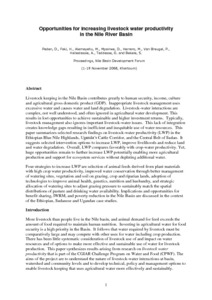Resource information
Livestock keeping in the Nile Basin contributes greatly to human security, income, culture and agricultural gross domestic product (GDP). Inappropriate livestock management uses excessive water and causes water and land degradation. Livestock-water interactions are complex, not well understood, and often ignored in agricultural water development. This results in lost opportunities to achieve sustainable and higher investment returns. Typically, livestock management also ignores important livestock-water issues. This lack of integration creates knowledge gaps resulting in inefficient and inequitable use of water resources. This paper summarizes selected research findings on livestock-water productivity (LWP) in the Ethiopian Blue Nile Highlands, Uganda?s Cattle Corridor, and the Central Belt of Sudan. It suggests selected intervention options to increase LWP, improve livelihoods and reduce land and water degradation. Overall, LWP compares favorably with crop-water productivity. Yet, huge opportunities remain to further increase LWP potentially enabling more agricultural production and support for ecosystem services without depleting additional water. Four strategies to increase LWP are selection of animal feeds derived from plant materials with high crop water productivity, improved water conservation through better management of watering sites, vegetation and soil on grazing, crop and riparian lands, adoption of technologies to improve animal health, genetics, nutrition and husbandry, and strategic allocation of watering sites to adjust grazing pressure to sustainably match the spatial distributions of pasture and drinking water availability. Implications and opportunities for benefit sharing, IWRM, and poverty reduction in the Nile Basin are discussed in the context of the Ethiopian, Sudanese and Ugandan case studies.



